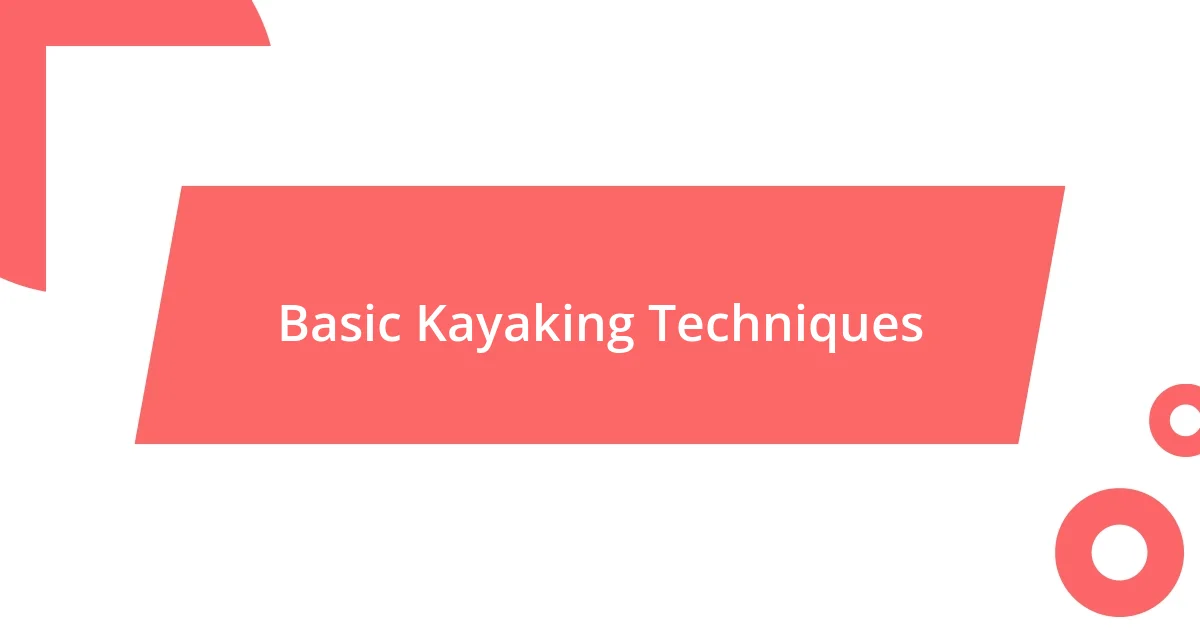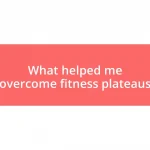Key takeaways:
- Choose the right kayak based on water conditions, personal size, and skill level to enhance stability and comfort.
- Invest in essential gear, such as a suitable personal flotation device (PFD) and paddle, while dressing in appropriate clothing for weather conditions for a safe kayaking experience.
- Embrace basic techniques and safety practices, remain calm when faced with challenges, and explore local kayaking spots to enrich your kayaking journey.

Choosing the Right Kayak
When I first embarked on my kayaking journey, choosing the right kayak felt overwhelming. I remember standing in front of a row of different models, feeling a mix of excitement and confusion. Have you ever faced a decision where every option seemed like a great choice yet daunting at the same time?
One crucial factor to consider is the type of water you’ll be paddling in—calm lakes, rushing rivers, or the open sea. For me, selecting a kayak for a calm lake meant prioritizing stability and comfort over speed. I once borrowed a friend’s sleek, fast kayak for a gentle paddle, only to find myself nervously trying to balance rather than enjoying the scenery.
Don’t forget about your own size and skill level! As a beginner, I quickly realized that a wider kayak provides more stability, which helped build my confidence on the water. Finding the right fit feels like finding a trusted companion for your adventures; it should make you feel at ease while still challenging you just enough to grow as a paddler.

Essential Gear for Kayaking
Having the right gear is absolutely essential for a successful kayaking experience. I still recall my first outing where I forgot to wear a personal flotation device (PFD). That moment of anxiety when I realized it was at home, while I was on the water, made me understand the critical importance of safety gear. A good PFD isn’t just a requirement; it’s a lifesaver that provides peace of mind. It’s designed to keep you afloat and can be quite comfortable if you choose one that fits well, allowing for ease of movement.
In addition to a PFD, having an appropriate paddle is vital. I vividly recall the first time I used a paddle that was too short—my strokes felt awkward, and I was exhausted after just a short while. A suitable paddle should match your height and the width of your kayak for efficient paddling. Finding that sweet spot can transform your kayaking experience from tiring to enjoyable, enabling you to spend more time soaking in the serene beauty of your surroundings without the struggle.
Lastly, appropriate clothing can make a big difference in your kayaking adventures. I once set off on a cool morning in a standard cotton t-shirt, and as the day progressed, I ended up soaked and shivering. Investing in quick-dry, moisture-wicking materials or a good wetsuit is something I highly recommend. It keeps you comfortable and protected from the elements, ensuring you can focus on paddling rather than battling the weather. Pay attention to what you wear—your comfort can significantly affect your enjoyment on the water.
| Gear | Purpose |
|---|---|
| Personal Flotation Device (PFD) | Safety and buoyancy |
| Paddle | Efficient propulsion |
| Clothing | Comfort and protection |

Basic Kayaking Techniques
Mastering basic kayaking techniques can be a game changer in your overall experience on the water. I’ll never forget the first time I attempted a proper stroke. I was full of enthusiasm, but my form was all over the place! The instructor clued me into the essentials, which helped me gain confidence pretty quickly. Here are some foundational techniques to get you started:
-
The Forward Stroke: This is your primary way of propelling the kayak. Imagine reaching forward with your paddle, sinking it deep, and pulling it alongside the kayak. I found that keeping my elbows slightly bent helped maintain a fluid motion.
-
The Reverse Stroke: If you need to slow down or back up, this technique is your friend. It’s similar to the forward stroke but in reverse—paddle backwards while keeping your stroke consistent for controlled movement.
-
The Sweep Stroke: This is a great maneuver for turning. By sweeping the paddle out to the side in a semi-circle, your kayak glides in the direction you want to go. It felt like a dance move at first, but with practice, it became more intuitive.
-
Edging: As I learned to edge my kayak—tilting it slightly to one side—I was surprised at how much control I gained. This technique is especially helpful when navigating through windy conditions or sharp turns.
I could go on about how each of these techniques opened new doors to enjoying the water! As I practiced, I became more aware of body positioning and how subtle shifts influenced my balance. At times, I felt like I was on the verge of tipping over. But each time I steered my kayak or corrected my stroke, it made me appreciate the flow of the water beneath me even more. Like many experiences, practice makes progress. Here are a few more tips to keep in mind while you’re on your journey:
-
Keep Your Core Engaged: Your core is where the power comes from. I noticed a big improvement when I focused on using my torso to drive my strokes rather than just my arms.
-
Relax Your Grip: I learned (the hard way!) that over-gripping the paddle can lead to fatigue. A gentle, relaxed hold gives you better control and less strain.
-
Look Ahead: This might seem simple, but keeping your gaze ahead rather than down at the water changes everything. It helps in guiding your kayak smoothly and can prevent misdirection.
-
Practice Rescue Techniques: Even though I hoped I’d never need them, knowing how to perform a wet exit and a self-rescue boosted my confidence immensely. It’s like knowing how to swim—good to have under your belt!

Safety Tips for Beginners
It’s crucial to prioritize safety when you’re just starting out with kayaking. One piece of advice that really resonated with me is to always check the weather before heading out. I recall a day when sunny skies turned stormy in the blink of an eye. Knowing how quickly conditions can change made me invest in a reliable waterproof phone case. Now, I keep a weather app handy to stay informed, ensuring that I’m never caught off guard again.
Also, it’s essential to let someone know your plans for the day. I learned this the hard way when I took a solo trip on a less popular river. I ended up getting stuck in some shallow waters, and while I managed to paddle out safely, I couldn’t shake the feeling of being alone and unaccounted for. Now, I always share my itinerary with a friend or family member. This simple step adds an extra layer of security and peace of mind, allowing for a more enjoyable time on the water.
Lastly, familiarizing yourself with your kayak is non-negotiable. During my first outing, I was so excited that I barely spent any time adjusting my seat and foot pegs. It felt uncomfortable, especially after an hour of paddling! Take a few minutes to adjust your gear and get comfy before you launch. Trust me, being secure in your kayak greatly enhances your control and reduces fatigue, letting you enjoy the adventure without unnecessary strain. Don’t let minor discomforts ruin what could be an extraordinary day on the water!

Overcoming Common Challenges
When I first started kayaking, balancing the vessel felt like a shaky game of Jenga. I vividly remember my first attempt to navigate over some small waves. I braced myself, focused, and then—a sudden shift made me wobble precariously. But instead of panicking, I reminded myself to breathe and trust my instincts. That moment taught me the power of staying calm in the face of unexpected challenges.
Another challenge was learning how to handle the paddle effectively with the wind gusting at my side. I often found myself paddling harder against the breeze, which only left me exhausted and frustrated. One day, my instructor suggested I simply angle my paddle differently to cut through the wind rather than fighting it. It was a simple tweak but made a world of difference! Have you ever noticed how adapting your approach can sometimes unlock solutions you never thought of?
Finally, it can be tricky to find the right pace during long trips. Initially, I was so eager to keep up with everyone that I pushed myself to the limit. I learned the hard way that fatigue can sneak up on you during a leisurely outing. Now I focus on establishing a steady rhythm, taking breaks when needed, and enjoying the scenery. It’s all about balance—not just in the kayak but in the flow of the experience itself. How do you find your rhythm in new activities?

Finding the Best Kayaking Spots
When I started my kayaking journey, discovering the right spots was both exciting and a bit daunting. I remember eagerly researching local lakes and rivers online, but nothing compared to the thrill of hearing about hidden gems from seasoned kayakers. There’s something special about those less-traveled paths, right? I recommend checking out local kayaking forums or community groups, where people often share their favorite locations, complete with tips on how to navigate each one.
Once I found a beautiful cove nestled away from the typical hotspots, it quickly became one of my cherished places to paddle. The calm waters surrounded by towering trees created such a peaceful atmosphere. That first time I glided silently across the surface, watching the sunlight dance through the leaves, I felt an overwhelming sense of connection to nature. Trust me, experiencing that serenity firsthand is absolutely worth the search for the ideal spot.
One thing I’ve learned is that the best kayaking spots aren’t just about picturesque views—they’re also about the overall experience they offer. For instance, I once paddled through a winding river with curious turtles peeking at me from the banks. It was so delightful, I couldn’t help but chuckle! I began to appreciate how these little moments made each outing unique. Have you ever stumbled upon a location that left you in awe? Those unexpected treasures can turn a simple kayaking trip into a memorable adventure.

Reflecting on the Learning Journey
Reflecting on my learning journey in kayaking, I’ve come to realize how each moment on the water became a lesson in resilience. I recall a particularly windy day when I took a wrong turn and found myself gliding towards the unknown. Instead of feeling panic, I experienced a strange mix of anxiety and excitement, which pushed me to adapt and navigate back. It made me appreciate how the unexpected can lead to growth, both on the water and in life.
As I look back, I often think about the importance of mentorship in my kayaking experience. My instructor shared tales of his first kayaking attempts, filled with blunders and lessons learned. It was encouraging to hear that even seasoned kayakers had their learning curves. These shared experiences fostered a sense of community that I cherish deeply. Have you ever felt that connection with someone who has experienced similar challenges?
In reflecting on my progress, I’ve noticed a subtle yet profound shift in my mindset. Early on, I focused solely on mastering techniques, but now I relish the experience itself—the rhythm of the paddle, the sound of splashing water, the way the sunlight sparkles on the surface. Each outing has become more than just a practice session; it’s a meditative escape from everyday life. How about you? Have you found moments in your hobbies that transcend the technical aspects and offer deeper tranquility?















